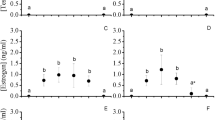Abstract
The concentration of the sex steroids 17β-estradiol, testosterone and progesterone was determined by specific enzyme-linked immunosorbent assays in the hemolymph of the mussel Mytilus galloprovincialis and related to its sexual maturation. A non-lethal hemolymph sampling procedure was used in mussels matured in controlled conditions of a hatchery. To our knowledge, this is the first study on sexual steroid hormones of a bivalve species using the same specimens in consecutive samplings. Histological data showed that nearly 90 % of the mussels ripened during the experiment. Steroid analyses revealed that 17β-estradiol and testosterone were closely related to the onset of gamete development, while progesterone would have an important role at the end of gonadal maturity. This method can be used to assess sexual maturation in bivalves when conditioning in hatcheries, without killing them.

Similar content being viewed by others
Abbreviations
- ELISA:
-
Enzyme-linked immunosorbent assays
- CI:
-
Condition index
- S1:
-
First sampling
- S2:
-
Second sampling
- AP:
-
Anteroposterior length
References
Blaise C, Gagné F, Pellerin J et al (1999) Determination of vitellogenin-like properties in Mya arenaria hemolymph (Saguenay Fjord, Canada): a potential biomarker for endocrine disruption. Environ Toxicol 14:455–465
Croll RP, Wang C (2007) Possible roles of sex steroids in the control of reproduction in bivalve molluscs. Aquaculture 272:76–86
Gagné F, Blaise C, Salazar M et al (2001) Evaluation of estrogenic effects of municipal effluents to the freshwater mussel Elliptio complanata. Comp Biochem Phys C 128:213–225
Gauthier-Clerc S, Pellerin J, Fournier M et al (2006) Immunological and biochemical responses in Mya arenaria (Mollusca Bivalvia) exposed in vivo to estradiol-17β. Comp Biochem Phys C 144:228–234
Gustafson LL, Stoskopf MK, Bogan AE et al (2005) Evaluation of a nonlethal technique for hemolymph collection in Elliptio complanata, a freshwater bivalve (Mollusca: Unionidae). Dis Aquat Organ 65:159–165
Janer G, Lavado R, Thibaut R et al (2004) Effects of 17b-estradiol exposure in the mussel Mytilus galloprovincialis. Mar Environ Res 58:443–446
Lafont R, Mathieu M (2007) Steroids in aquatic invertebrates. Ecotoxicology 16:109–130
Liu W, Li Q, Kong L (2008) Estradiol-17b and testosterone levels in the cockle Fulvia mutica during the annual reproductive cycle. N Z J Mar Freshw 42:417–424
López C, Caballal MA, Villalba A (1997) Morphological characterization of the hemocytes of the clam, Ruditapes decussatus (Mollusca: Bivalvia). J Inv Pathol 69:51–57
López-Galindo C, Vargas-Chacoff L, Nebot E et al (2010) Sublethal responses of the common mussel (Mytilus galloprovincialis) exposed to sodium hypochlorite and Mexel®432 used as antifoulants. Ecotox Environ Safe 73:825–834
Martínez-Pita I, Sánchez-Lazo C, Ruíz-Jarabo I et al (2012) Biochemical composition, lipid classes, fatty acids and sexual hormones in the mussel Mytilus galloprovincialis from cultivated populations in south Spain. Aquaculture 358–359:274–283
Martínez-Pita I, Sánchez-Lazo C, García FJ (2014) Influence of microalga lipid composition on the sexual maturation of Mytillus galloprovincialis: a hatchery study. Aquac Nutr. doi:10.1111/anu.12248
Matsumoto T, Osada M, Osawa Y et al (1997) Gonadal estrogen profile and immunohistochemical localization of steroidogenic enzymes in the oyster and scallop during sexual maturation. Comp Biochem Phys B 118:811–817
Moss M (1989) Effects of exogenous androgens on growth, biochemical composition and reproduction of the coot clam Mulinia lateralis. Pac Sci 43:200
Mouneyrac C, Linot S, Amiard J-C et al (2008) Biological indices, energy reserves, steroid hormones and sexual maturity in the infaunal bivalve Scrobicularia plana from three sites differing by their level of contamination. Gen Comp Endocr 157:133–141
Negrato E, Marin MG, Bertotto D et al (2008) Sex steroids in Tapes philippinarum (Adams and Reeve 1850) during gametogenic cycle: preliminary results. Fresenius Environ Bull 17:1466–1470
Osada M, Takamura T, Sato H et al (2003) Vitellogenin synthesis in the ovary of scallop, Patinopecten yessoensis: control by Estradiol-17b and the central nervous system. J Exp Zool A 299:172–179
Osada M, Tawarayama H, Mori K (2004) Estrogen synthesis in relation to gonadal development of Japanese scallop, Patinopecten yessoensis: gonadal profile and immunolocalization of P450 aromatase and estrogen. Comp Biochem Phys B 139:123–128
Reis-Henriques MA, Coimbra J (1990) Variations in the levels of progesterone in Mytilus edulis during the annual reproductive cycle. Comp Biochem Phys A 95:343–348
Reis-Henriques MA, Le Guellec D, Remy-Martin JP, Adess GL (1990) Studies of endogenous steroids from the marine mollusc Mytilus edulis L. by gas chromatography and mass spectrometry. Comp Biochem Phys B 95:303–309
Siah A, Pellerin J, Benosman A et al (2002) Seasonal gonad progesterone pattern in the soft-shell clam Mya arenaria. Comp Biochem Phys A 132:499–511
Tirado C, Macías JC, Villarías RM et al (2005) Studies on the potential of mussel Mytilus galloprovincialis Lamarck, 1819 farming in Andalusia. Bol Inst Esp Oceanogr 21:455–464
Varaksina GS, Varaksin AA (1991) Effects of estradiol, progesterone, and testosterone on oogenesis of yezo scallop. Biol Morya 3:61–68
Varaksina GS, Varaksin AA, Maslennikova LA (1992) The role of gonadal steroid hormones in the spermatogenesis of the scallop Mizuhopecten yessoensis. Biol Morya 3:77–83
Villalba A (1995) Gametogenic cycle of cultured mussel, Mytilus galloprovincialis, in the bays of Galicia (N.W. Spain). Aquaculture 130:269–277
Wang C, Croll RP (2004) Effects of sex steroids on gonadal development and gender determination in the sea scallop, Placopecten magellanicus. Aquaculture 238:483–498
Acknowledgments
This research was financed by the project “Viabilidad del cultivo de mejillón (Mytilus galloprovincialis) a partir de semilla producida en criadero” supported by the Junta de Andalucía (Andalucía, Spain). M. Herrera postdoc contract was supported by INIA-FSE.
Author information
Authors and Affiliations
Corresponding author
Rights and permissions
About this article
Cite this article
Martínez-Pita, I., Sánchez-Lazo, C. & Herrera, M. A non-lethal method for establishing sexual maturation in mussels (Mytilus galloprovincialis (Lamarck, 1819)) during broodstock conditioning in hatcheries. Aquacult Int 24, 1247–1254 (2016). https://doi.org/10.1007/s10499-016-9981-4
Received:
Accepted:
Published:
Issue Date:
DOI: https://doi.org/10.1007/s10499-016-9981-4




